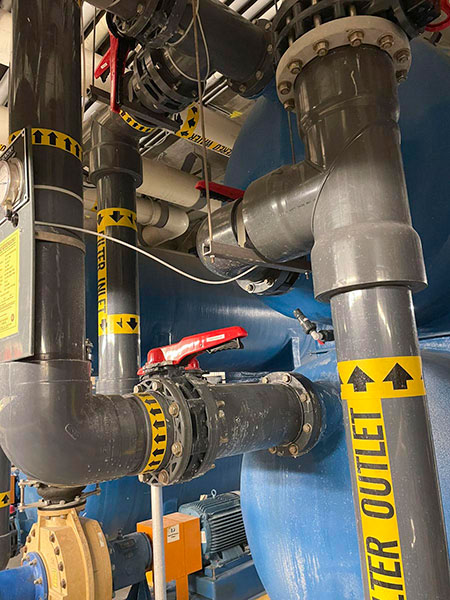
In a fluid process system, selecting the right materials for critical components, like valves, is crucial for ensuring optimal performance and longevity. While metal valves have been the standard for decades, thermoplastic valves present a compelling alternative.
This article explores the emergence of thermoplastic valves, their potential in fluid control systems and two real-world application case studies where thermoplastic valves replaced failing metallic valves.
Thermoplastic Valve Properties
Thermoplastics have garnered attention across industries for their ability to soften under heat and harden upon cooling. This characteristic has led to a surge in the use of thermoplastic valves and has been further driven by their versatility, durability and performance.
Advantages
Thermoplastic valves offer advantages in corrosion resistance and ease of installation. With exceptional corrosion resistance, they are ideal for use in aggressive chemical environments where metal valves might degrade over time. Their lightweight properties simplify transportation, handling and installation processes, reducing labor costs and eliminating the need for heavy support structures.
Additionally, thermoplastic valves prove to be cost-effective in the long run. While metal valves may have lower
upfront costs, thermoplastics offer durability and longevity, resulting in reduced life cycle costs due to minimal maintenance, repairs and replacements. Their chemical resistance ensures reliable performance across diverse industrial applications without the risk of material degradation.
Their flexibility and design versatility allow for customized valve configurations to meet specific application requirements, optimizing overall performance. The smooth internal surface of thermoplastic valves reduces frictional losses, resulting in lower energy consumption compared to metal valves, thus contributing to both cost savings and environmental sustainability.
Thermoplastic Valve Applications Across Industries
Application 1: Enhancing water filtration systems at Typhoon Lagoon
The application of thermoplastic valves at Typhoon Lagoon at Walt Disney World in Orlando, Florida, showcases the versatility and effectiveness of thermoplastic valves across various industries, particularly in environments prone to corrosion and chemical exposure. Over 20 years ago, Typhoon Lagoon originally relied on metal butterfly valves for their water filtration system; however, they faced issues with corrosion and reliability over time.
Upon inspection, it was evident many of the existing metal butterfly valves deteriorated due to corrosion, leading to ineffective filtration. To address this, a valve manufacturer introduced an 8-inch thermoplastic lug insert butterfly valve as a potential replacement. Customization was essential to ensure compatibility with the existing infrastructure, requiring longer shaft dimensions compared to standard valves.
Typhoon Lagoon’s interest in adopting thermoplastic valves highlights these valves’ growing recognition for benefits like durability and cost-effectiveness. This shift enhances the reliability and efficiency of their water filtration system and minimizes maintenance costs and downtime, ensuring a better experience for visitors.
Application 2: Improving life support systems at Mandalay Bay
Mandalay Bay Aquarium in Las Vegas, Nevada, renowned for its interactive shark reef exhibit, relies on sand filters for critical life support purposes to sustain water quality. However, they were experiencing constant leaks and corrosion issues with their existing stainless steel butterfly valves, which prompted the switch to thermoplastic 316 stainless steel lug inserted butterfly valves. The replacement process was straightforward, as the new valves served as a direct retrofit for the existing metallic ones, eliminating the need for spacers or re-piping. The decision to transition to thermoplastic valves has proven to be a lasting solution, as they withstand saltwater service, significantly reducing downtime and associated labor costs. Currently, they are still in operation without issues. Mandalay Bay’s experience emphasizes the effectiveness of thermoplastic valves in harsh environments, offering reliability and longevity crucial for sustaining critical life support systems.
These two real-world applications serve as compelling examples of the growing prominence of thermoplastic
valves across industries. From enhancing water filtration systems to sustaining critical life support infrastructure, the versatility and reliability of thermoplastics are reshaping fluid control paradigms and offering facilities efficient, cost-effective and sustainable solutions for their operational needs.The versatility of thermoplastic valves extends across industries, including chemical processing, water treatment, life support systems, pharmaceuticals, food and beverage manufacturing and semiconductor manufacturing.
As industries continue to prioritize efficiency, reliability and sustainability, the adoption of innovative technologies becomes imperative. Thermoplastic valves represent an advancement in valve technology. With excellent corrosion resistance, lightweight construction, cost-effectiveness and design versatility, thermoplastic valves can benefit fluid control systems across various sectors, driving progress toward a more efficient and sustainable future.


